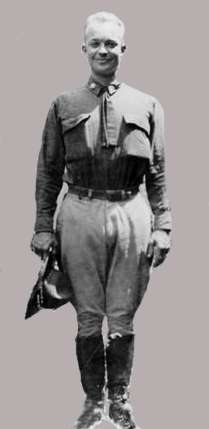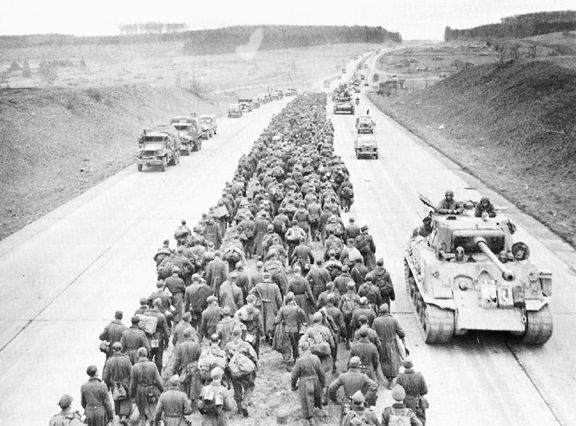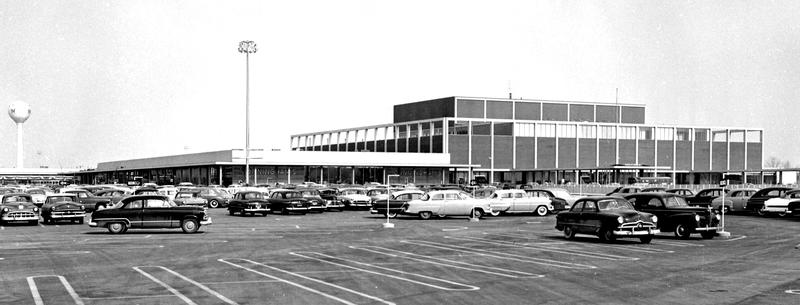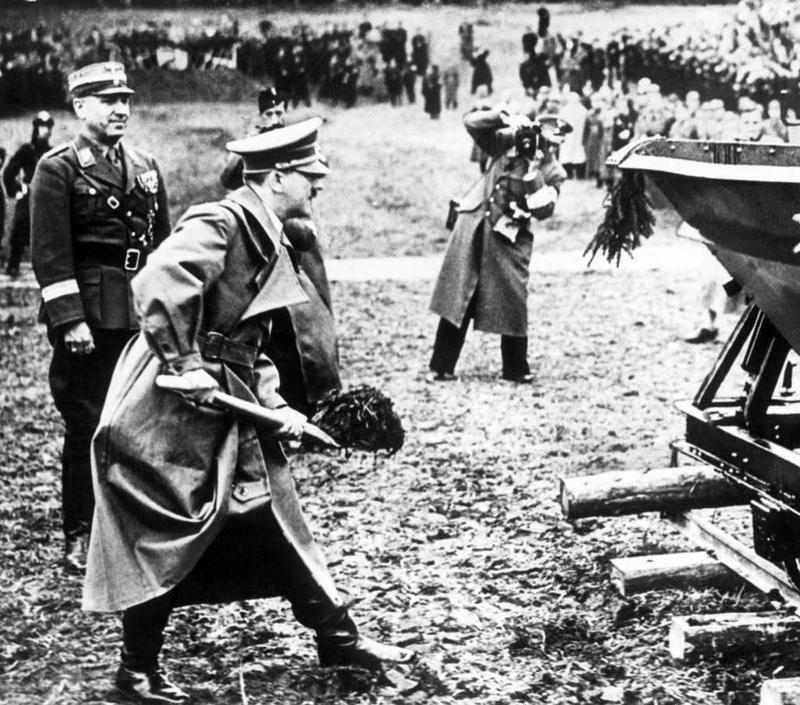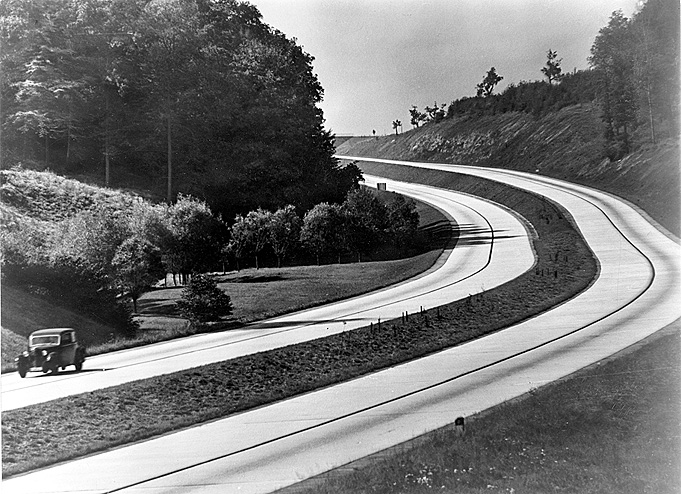President Eisenhower flashes the victory sign to Detroiters as his motorcade proceeds up Washington Avenue during a stopover. The 1950s were Ike’s decade. His highway legislation would have a significant impact on the face of big urban areas like Detroit with the creation of federal interstates. While interstates greatly advanced transportation, it had the double negative effect of carving up viable urban communities and paving the way for “white flight” to the fledgling suburbs, which they helped create.
East Side - The Chrylser Colossus
It was an embarrassing realization that the country which put the world on wheels and developed the atomic bomb had no major system of roads linking one state to another. The concept had been bantered around before Eisenhower but Washington was never serious enough to appropriate the massive funds necessary to carry out this Herculean task. WWII and the Cold War scared them into action.
Ike’s Federal Highway Act of 1956 gave him the financial clout to fulfill his super highway vision. The federal government would now foot 90 percent of the bill while giving local governments free rein on freeway placement. Like urban renewal, no one really understood the ramifications of carving up large tracts of urban areas and running a maze of expressways through once vibrant neighborhoods. Thus began the catastrophic marriage between urban renewal and interstate highways which would have massive repercussions for big cities in the decades to come.
Freeway construction wreaked havoc on Detroit. The installation of the Chrysler Freeway carved a jagged swath right through many well established Detroit neighborhoods, essentially taking one large city and splitting it up into many smaller ones, thus destroying much of its ethic congruity. This meager stretch of expressway from East Jefferson to 8 Mile, which cost a hefty $121 million, was completed in 1967.
Escape of the Middle Class
U.S. army troops pass German POW's on the Autobahn in 1945. The Autobahn, built by Hitler
in the 1930s, was the world's first super highway. As Supreme Commander of Allied forces, Eisenhower marveled at how fast he could move troops and equipment on the Autobahn. It was one of many lessons he would bring with him to the Oval office eight years later.
There were unforeseen aftereffects however. Interstates now provided the apparatus for over crowded
urbanites to pursue the “grass and garage” of the suburbs. City officials naively believed the opposite would occur. The dream of living in maiden suburbia and commuting to work in Detroit had arrived, and with it the mad dash of white flight to the suburbs went into overdrive.
White flight was not strictly racially based however. Detroit’s ancient housing stock also played a role. Houses
built before the automotive era didn’t have garages or driveways. Many homes were built almost within arms reach of their neighbors, completely negating the concept of privacy. In conjunction with this, yards were so small they were for all practical purposes nonexistent, which greatly limited the types of recreational activities for the kids.
Another telling side effect of interstates were the creation of suburban malls like Northland (above) which opened in 1954. The interstates not only provided the vehicle for people to commute from suburbs to city but with major shopping malls right next door there was one less reason to go downtown, robbing the city of more sources of revenue and led to the closing of the worlds largest
department store, J.L. Hudson's.
Throughout the 1950's the Cold War between America and the Soviet Union raged. In response to this, Ike vowed to create a vast network of roads across the country enabling civilians and the military alike the capacity of
mass transit with great alacrity during times of war or peace. In selling his idea, Ike stated in 1955:
While leading the American army through Germany towards the end of WWII, Ike marveled at how fast and efficiently he could move his troops and equipment on the world’s first superhighway, the Autobahn. Experiences on the home front during the war also emphasized the point that America’s antiquated system of roads was wholly deficient in times of crisis.
Ike has an Idea - Interstates
When General Dwight Eisenhower became president in 1953 he brought with him an expansion of a revolutionary idea. His odyssey of forty-one years in the U.S. Army enriched him with vast array of sociological experiences he would take to the White House. Chief among them was his modernistic version of transportation. As the Cold War heightened, Ike worried that, if WWIII started, was America's transportation system up to the task? He decided it was not and nobody knew better then him.
Two events led Ike to this inevitable conclusion. First, in 1919, right after WWI, the U.S. Army decided to conduct an experiment. They would take an army convoy of vehicles from Washington D.C. to San Francisco, some 3200 miles, most of which was unpaved roadway, recording all the trials and tribulations along the way. Known as the U.S. Army Transport Convoy, Lt. Col. Eisenhower would tag along. The goal was to harness a complete understanding of America's infantile road system.
The Lincoln Highway in 1919 - One of the more advanced American roads of the day.
The Trans Continental Convoy left Washington with high hopes but in total ignorance of the challenges that lay in wait.
As Mayor Albert Cobo stands besides the Lodge / I-94 interchange in 1956, he believed (and hoped) that the interstates would help bring people back to the dwindling city. All big city mayors were in search of solutions to halt white flight and as the 1960's approached, they realized they were running out of time.
The army encountered all too numerous unforeseen obstacles along the way and staggered into San Francisco some three months later. But there was no hiding the naked truth. The U.S. transportation system of 1919 was a shambles, hardly any better than it was during days of the Pony Express.
Ike gets schooled from an unlikely source
Hitler takes the first ceremonial shovel of earth at the ground breaking of the Autobahn.
Completed section of the Autobahn in 1936 was historically significant because it was the world's first super highway.
"Together, the united forces of our communication and
transportation systems are dynamic elements in the very
name we bear — United States. Without them, we would
be a mere alliance of many separate parts."
- President Eisenhower
Symbols of two eras - As one of the last steam trains lumbers over the newly opened Lodge Freeway in 1950 it became a symbolic passing of the transportation torch from trains to automobiles. The freeways did what they were designed to do - move large amounts of people and freight quickly and efficiently, local and long distance.
Interstates - The Double Edged Sword
